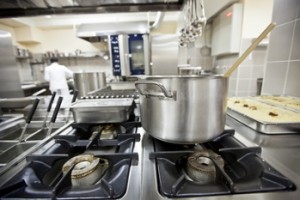 Designing your kitchen around function, and working with the space you already have, will help you utilize the area to its highest potential. These “master” kitchens are great because of the appliances they have in them, but it’s also about the design of the space – everything works together to give you the best work triangle or zones possible.
Designing your kitchen around function, and working with the space you already have, will help you utilize the area to its highest potential. These “master” kitchens are great because of the appliances they have in them, but it’s also about the design of the space – everything works together to give you the best work triangle or zones possible.
Design
During their time cooking, chefs want to take as few steps as possible. The less they have to run around, the more they can focus on what they are cooking. You should follow these same rules when designing your chef’s kitchen. While the work triangle should always be implemented into a design, sometime it’s hard to create the proper flow when additional appliances are added into the mix. Before you make a final decision on the layout, try creating a life size version so you can truly see how each piece will work together (because you’ll never see a professional running around to a poorly placed appliance).
A chef’s kitchen also follows basic universal design principles in its layout. You will see doors that are easy to open, larger display screens, and wider pathways throughout the kitchen. The reason for this is because, at the pace they are moving, chefs need to be able to do things quickly and very easily. Most of the time, they are running around with a pot or pan in their hand – if they can’t open the oven door or turn off the stove, that could be the end of their meal.
Your chef’s kitchen doesn’t need to be a dream you have after watching a cooking show, it can be a reality with just a little planning. Take the time to think about how you will use the space and what type of chef you want to be in your kitchen, and then design to those needs. No matter what you choose to put in the space, you’ll be happy that you took the time to upgrade and improve your kitchen.

Recent Comments